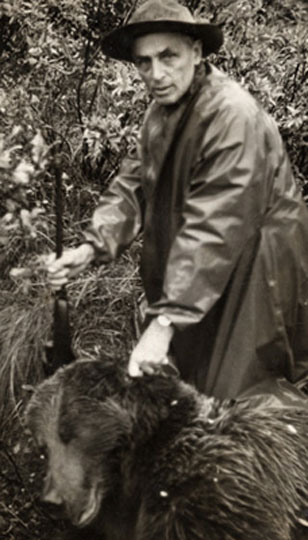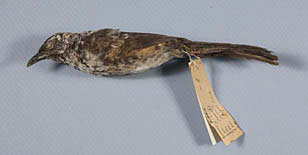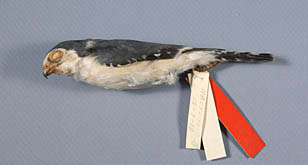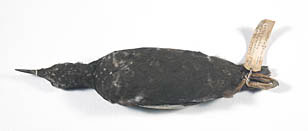Robert Ruliph Morgan Carpenter
(1877-1949)

Robert Ruliph Morgan Carpenter
Academy Archives, Coll.457, 4898
The only thing that competed with the sharpness of Robert Ruliph Morgan Carpenter’s business acumen was his sportsman’s instincts. As an executive at DuPont, R.R.M. Carpenter was one of the men responsible for the development and proliferation of consumer plastics in the twentieth century. But his leisure pursuits would take him far from the world of industrial chemistry, out into the wild spaces where he hunted big game for the Academy of Natural Sciences as well as his own trophy room. A trustee of the Academy, Carpenter brought down the Cape Buffalo, Pronghorn Antelope, and Mule Deer that are still on public display at the museum. His contributions also added thousands of birds to the Academy’s collection, helping finance the purchase of the A. Blayney Percival collection of East African Birds (1930) as well expeditions to Greenland, East Africa, Mexico, and the American West.
R.R.M. Carpenter was born in Wilkes-Barre, Pennsylvania in 1877. A graduate of the Massachusetts Institute of Technology, he joined the DuPont Company in 1906 as a purchasing agent, and married company president Pierre Du Pont’s sister, Margaretta, later that year. He would rise quickly through the ranks and play a crucial role in transforming DuPont into a modern scientific corporation. Carpenter spearheaded the company’s purchase of Pyrolin Plastics and Fabrikoid Artificial Leather, two early plastics that would change the history of DuPont and of the twentieth century.
When he wasn’t revolutionizing the material conditions of modern American life, Carpenter enjoyed tracking game with gun and camera. He didn’t just provide funds for Academy expeditions; he contributed his skills as a sharpshooter to help collect important specimens everywhere from the Arctic circle to the Sahara Desert. Sometimes his wife would come along, camping in the Klondike and keeping lookout for grizzly bears. Carpenter financed and accompanied Academy expeditions to Wyoming (1934, 1935), Alaska and Greenland (1933, 1934-5), East Africa (1936), and Sinaloa, Mexico (1938), and recounted these experiences in My African Safari (1937) and Game Trails from Alaska to Africa (1938). As he wrote in the latter, he hoped to induce readers to “drop out of some of the drudgeries of everyday life for a time and get out into the woods and fields.” His action-packed account of a horseback journey along the Healy River in Alaska to capture specimens of the elusive “Silver Ram”—Dall’s Sheep—can be found in the February 1941 issue of the Academy’s Frontiers magazine.
From July to September in 1934, the Carpenter Arctic Expedition collected birds and mammals in northern Canada (Labrador, Northwest Territory) and Greenland. At least 201 bird study skins were prepared during this expedition, including large series of all common breeding birds from this region. Particularly impressive from this collection are the large series of water birds, such as ducks and murres, that are typically very difficult to collect and can be even harder to prepare. As it happens, these are also some of the most important taxa in the study and documentation of global climate change. The changes in the breeding ranges of these northern breeding taxa are important indicators and, in fact, hard proof of, a warming planet.

Hindei’s Babbler
(Turdoides hindei)
ANSP 95794

Pygmy Falcon
(Polihierax semitorquatus castanonotus)
ANSP 93996, type

Black Guillemot
(Cepphus grylle mandtii)
ANSP 37621
A. Blayney Percival was a big game hunter, hunting guide, outfitter, lodge owner and expedition guide in east Africa in the early 1900’s. He led several of the Academy’s early patrons on hunting trips to the region and acted as the expedition guide for several early museum-wide collecting expeditions of this same era. Apparently, R. R. M. Carpenter was on a big game hunt with Percival as the guide and outfitter when he learned of Percival’s interest and ability in collecting birds for science. He immediately signed him up to do so for the Academy. Over the next several years (1910’s to 1920’s), Percival collected at least 5,800 bird skins for our collection (or helped to do so). These birds are one of the first modern collections from east Africa. They are particularly important for the huge series of certain species that were collected which are very important for statistical analyses in today’s studies. Many of the collecting sites visited during this work have been destroyed by urbanization or seriously altered by deforestation or overgrazing. Thus, these specimens represent the last examples from many of these locations. An example would be the series of Hindei’s Babbler, Turdoides hindei (ANSP 95794-6), an endangered species that is found only very locally in east Africa. Also of note are three new species of birds collected from this region: Jackson’s Francolin, Francolinus jacksoni (94159), Pigmy Falcon, Polihierax semitorquatus (93996), and Yellow-billed Shrike, Corvinella corvina (97846).
R.R.M. Carpenter’s final bequest to the Academy was essential in creating the Laboratory of Limnology, where Dr. Ruth Patrick conducted pioneering ecological research on stream and river conditions in Pennsylvania and beyond.
The Carpenter name may ring a bell for Phillies Phanatics. R.R.M Carpenter purchased the Phillies franchise in 1943 with his son, Robert Carpenter, Jr., who served as general manager. His grandson R.R.M “Ruly” Carpenter led it through its most successful period, including the team’s first World Series title in 1980.
In manifold ways, Robert R.M. Carpenter, left his distinctive mark on the Academy: as a Trustee; as a gifted collector of bird and mammal specimens; as a donor financing important expeditions, dioramas and research arms of the Academy; and as a vivid chronicler of his experiences in the wild.